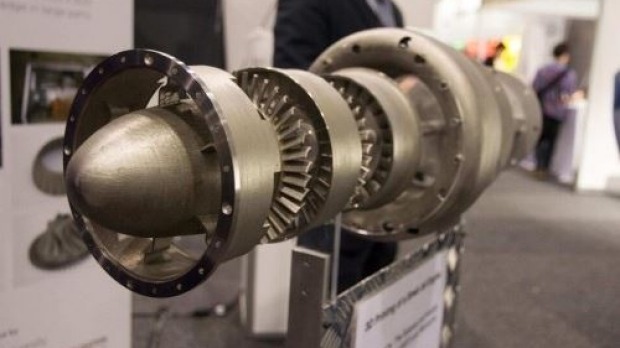3D printing is really taking off. Image: Monash Centre for Additive Manufacturing
Deep in the bowels of our Lab 22 manufacturing facility in Clayton, Melbourne, we’ve created something extraordinary – components for the world’s first 3D printed jet engine.
These engines aren’t just remarkable because they’ve been 3D-printed, but because they were created by using a range of different additive manufacturing technologies and successfully combined into a finished product that wouldn’t otherwise have been possible.
We used our Arcam Electron Beam Melting printer in combination with cold spray technology to produce a range of components for the engines, which also used a new titanium metal powder we developed that performs better than previously used products, and is also cheaper to use.
The 3D-printed jet engines (one was featured at the International Air Show in Avalon) prove that test parts can be produced in days instead of months. This could result in incredible benefits for the international aeronautical industry.
Here’s a video produced by the team at Monash that shows the process behind the printing.
Monash University’s Centre for Additive Manufacturing led the project in collaboration with our Lab 22 researchers and Deakin University. The project was supported by funding from the Science Industry Endowment Fund (SIEF).
SEIF is a Fund that strategically invests in scientific research for the national benefit – helping Australian industry, furthering the interests of the Australian community or contributing to the achievement of Australian national objectives. The fund supports collaborative partnerships between scientific, research and tertiary institutions, with an emphasis on exchange of scientific knowledge and ideas.
As we continue to expand our range of additive manufacturing machines at Lab 22, we’re able to further push the boundaries by developing new techniques that harness the expanded commercial and technical capabilities available.
Projects like this are helping put us at the forefront of the global aerospace industry and attract the attention of international companies looking to create stronger ties with Australian manufacturing.
The jet engine adds to a growing list of amazing things we’ve done with additive manufacturing such as custom made heels, mouthguards, horseshoes, bikes and of course dragons.



14th April 2016 at 10:26 am
Is this engine work or just prototype? Engine technology is very complex and there is no company in australia who build any thing related to engine except usa or euro company based in australia. If all mechines and technology used in this project already in market then what you guys did special in this project? Do you got any new patent or technology advancement?
4th March 2015 at 4:36 am
The article says “We used our Arcam Electron Beam Melting printer in combination with cold spray technology to produce a range of components for the engines…”. The only additive machine I recognize in the included video is an EOS M280???
Can you clarify what machine was used to make the small jet engine?
Thank you.
4th March 2015 at 9:33 am
Hi Charlie,
The video showcases the Monash University team’s part in the project. Our team was responsible some of the components for the jet engine. We have some further information on the machines we used, in the comment above.
We hope that helps clarify your question.
4th March 2015 at 3:08 pm
Thank you. Right now, I don’t know what technology was used for what components and what the reasoning was for applying each. For me, explaining why something is done a certain way is at least as important as how it’s done.
I’d be fascinated to see a more detailed description on how the different parts were produced and the rational for using one technology over another.
It’s exciting to see what’s been done at Csiro and Monash and Deakin Universities – even though you used the word “bowels”!
3rd March 2015 at 2:16 pm
Fantastic outcome. Could you explain a little more on what your joint research brings to the table over say someone else buying a large scale industrial 3D printer. Also I assume the finished product still required some final finishing processes, could they be discussed?
3rd March 2015 at 3:38 pm
Hi Cameron, we have put your questions to the manufacturing team responsible for 3D printing and we hope to get an answer to you shortly.
Regards,
Adam
Social media team
4th March 2015 at 9:24 am
Hi Cameron,
We have a response from the team:
“At the moment, we’re using an Arcam A1 machine and cold spray. The Arcam is a powder bed machine similar to many others, but uses an electron beam to melt the metal powder. We had the first one in the Southern Hemisphere. Because of the e-beam it is significantly faster than most of the other machines on the market and can melt higher temperature materials. The surface finish is rougher than its laser based brethren due in part to using larger powder particles which may mean more post process work like machining. It can however provide novel shapes that might be hollow or have structures inspired from nature. Each machine tends to have a sweet spot.
Cold spray is entirely new in this regime. Most people are only familiar with cold spray as a coating technique, but here we have deposited a near net shape of the shaft and gear. While it has a rough appearance, the big advantage of using cold spray as an AM technique is 45 kg/hr of titanium deposition. None of the other machines out there can come close to this. CSIRO is one of the few places in the world with this kind of technology to produce bulk shapes.
What we know is metal powders and how to make processes like AM better via better powders and better metallurgy.”
We hope that helps.
Adam
Social media team
14th April 2016 at 10:28 am
If any company in australia want to build an small jet plane what technology / know how you guys can provide to build jet engine?